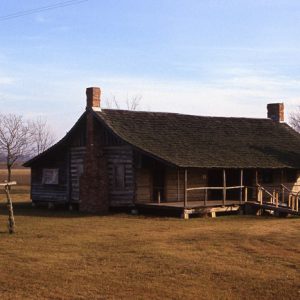calsfoundation@cals.org
Arkansas Post Museum
| Location: | Arkansas County |
| Area: | 8 acres |
The Arkansas Post Museum (previously Arkansas Post Museum State Park) in southeastern Arkansas displays exhibits and artifacts and presents programs about Arkansas Post—the first permanent European settlement in the state—and life in the state’s Delta region, including the Grand Prairie. It succeeded Arkansas Post State Park, which was transferred to the National Park Service in 1964 for creation of the Arkansas Post National Memorial. The museum complex is located at the junction of Highways 165 and 169.
The Arkansas Post State Park Commission, established by Legislative Act 57 of 1929, acquired sixty-two acres that had been occupied by Arkansas Post when it became the capital of Arkansas Territory in 1819, when the territory was established. At the time of the park’s creation, there were no structures remaining of Arkansas Post, but some military trenches were found on the grounds. The site became Arkansas’s first historical state park. The Refeld-Hinman Log Cabin (circa 1877) was moved about two miles to the site and served as park headquarters. The Works Progress Administration (WPA) built overnight cabins to lodge the commission.
In December 1953, the Grand Prairie Historical Society was formed and began to preserve the legacy of settlers in Arkansas County’s southern territory from the establishment of the original Arkansas Post in 1686 forward. To display and protect collected artifacts, documents, and photographs, the society created a museum and archive, incorporated in 1960 as the Arkansas Post Museum. It was housed in the Refeld-Hinman cabin.
In 1960, Congress authorized the National Park Service to take over and develop the Arkansas Post site. Plans called for the national memorial to interpret Arkansas Post’s history from European settlement to the Civil War, a time frame into which the museum and the Refeld-Hinman cabin did not fit. The museum’s supporters began a relocation effort.
In 1963, the historical society purchased two acres for a new museum site at the intersection of Arkansas 169 and what is now U.S. 165, two miles from Arkansas Post National Memorial. In 1964, the Arkansas County Quorum Court appropriated funds for support of the new museum. A lawsuit challenging that action resulted in a landmark decision by the Arkansas Supreme Court, which said that support for museums represented valid expenditures of county funds. As a result, Arkansas Post County Museum became the first county-supported museum in Arkansas.
Due to research into the type of architecture in use at the time the seat of territorial government was moved from Arkansas Post to Little Rock (Pulaski County) in 1821, the new museum included a complex of four buildings: the main building housing the museum’s earliest artifacts along with territorial exhibits, a kitchen building, an office building, and a carriage house. Total cost of the project was $50,124.35. The Refeld-Hinman cabin was donated to the museum by the National Park Service and moved to its current location in 1967.
While the museum does have some territorial and Civil War artifacts, most of the exhibits focus on post–Civil War life on the Delta and the Grand Prairie along with the role agriculture played in the settling of these areas.
Later, additional land was acquired, and a fully furnished 1933 playhouse built with a wood-burning fireplace and electrical service was donated and relocated to the site.
The new museum was operated by the county from its opening in July 1966 until January 1997, when it was transferred to the Arkansas Department of Parks and Tourism (later the state parks division of the Department of Parks, Heritage, and Tourism), becoming Arkansas Post Museum State Park. Native Grand Prairie plant species have since been restored to three acres of the museum’s property.
Annual special events include a Heritage Celebration in May; Fright Night, an annual Halloween event, in October; a period Christmas Open House and Candlelight Stroll in December; and an annual Civil War Encampment.
For additional information:
Arkansas Post Museum. https://www.arkansasstateparks.com/parks/arkansas-post-museum (accessed July 6, 2022).
Staff of the Arkansas Department of Parks and Tourism


 Arkansas County Museum
Arkansas County Museum  Arkansas Post; 1689
Arkansas Post; 1689  Arkansas Post Dedication
Arkansas Post Dedication  Arkansas County Museum Displays
Arkansas County Museum Displays  Arkansas Post Museum State Park: Park Location
Arkansas Post Museum State Park: Park Location  Dogtrot Cabin
Dogtrot Cabin  Gallows
Gallows 




Comments
No comments on this entry yet.